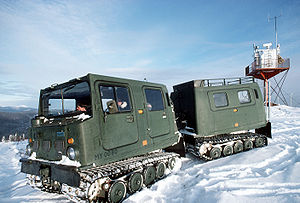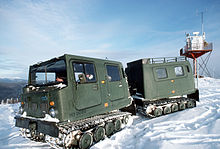Bandvagn 206
| Bandvagn 206/Bv 206 Armoured All Terrain Vehicle | |
|---|---|
 Swedish Bandvagn 206/Bv 206 | |
| Type | Armoured vehicle |
| Place of origin | Sweden |
| Production history | |
| Designer | Hagglunds |
| Specifications | |
| Mass | 4.5 tonnes |
| Length | 6.9 m |
| Width | 1.87 m |
| Height | 2.4 m |
| Crew | driver + 5 passengers (front car), 11 passengers (rear car) |
Main armament | heavy machine gun on ring mount |
Secondary armament | smoke grenade launchers (front), mortars (back) |
| Engine | 2.8L 99 kW Ford Cologne V6. 202 kW (275 hp) |
| Maximum speed | 65 km/h (roads) 5 km/h (water) |
Bandvagn 206 (Bv 206) (meaning "Tracked Vehicle 206" in English) is a tracked articulated, all-terrain carrier developed by Hägglunds (now part of BAE Systems Global Combat Systems) for the Swedish Army. It consists of two units, with all four tracks powered. It can carry up to 17 people (6 in the front compartment, 11 in the rear), and the trailer unit can be adapted for different uses (see Variants section).

History

Development of the Bv 206 all-terrain articulated tracked carrier began in 1974. Three batches of trial vehicles were delivered between 1976 and 1978 and the first production examples were delivered to the Swedish Defense Administration in 1980.
Like its predecessor, the Volvo Bv 202, the Bv 206 is designed to carry troops and equipment through snow and bog-lands in northern Sweden. The low ground pressure enables the Bv 206 to cope with a wide range of difficult conditions. It is also fully amphibious, with a speed in water of up to 4.7 kilometres per hour (2.9 mph). Over 11,000 have been produced and they are used in more than 37 countries worldwide.
The total load capacity is 2,250 kilograms (4,960 lb) and a trailer of up to 2,500 kilograms (5,500 lb) gross weight can also be towed behind the second compartment.
The Bv 206 is referred to as a Small Unit Support Vehicle (SUSV) pronounced "susvee" in United States service. U.S. military variants include the standard model (M973), a tactical operations center variant (M1065), an ambulance variant (M1066) and a flat-bed cargo carrier (M1067). U.S. military models are fitted with a 6-cylinder Mercedes diesel engine and a non-halon fire suppression system since 1997 due to several cases where the front car caught fire and burned to the frame.

Users include the American and Australian Antarctic research organizations and British, Icelandic and Canadian search and rescue services. They are also used for search and rescue services in the Austrian alpine region. The Bv 206 was used in combat by the Canadian Army during Operation Anaconda. The Singapore Armed Forces uses the Bv 206, and recently transferred several of them to the Singapore Civil Defense Force for use as a firefighting platform.
Decommissioned units have been purchased by private owners and rented as transports, particularly in Alberta, Canada, to access remote oil wells, as well as cut blocks which need to be reforested by tree planting.
The Bv 206 is used in Antarctica, Brazil, Canada, Chile, China, Estonia, Finland, France, Germany, Greece, Ireland, Israel, Indonesia, Italy, Lithuania, Latvia, Malaysia, Mexico, the Netherlands, New Zealand, Norway, Pakistan, Singapore,[citation needed] South Korea, Spain, Sweden, the United Kingdom, and the United States.
Variants

Bv 206A
The Bv 206A is an ambulance version, which is capable of carrying stretchers in the rear compartment.
Bv 206F
The Bv 206F is a fire appliance variant.
RaBv 2061
The RaBv 2061 (RadioBandvagn 2061) is a Swedish Army communications/command version, fitted with radio equipment and workplaces for staff members.
PvBv 2062
The PvBv 2062 (PansarvärnsBandvagn 2062) is a Swedish Army anti-tank vehicle, an open top version of the Bv 206 armed with a 90 mm Pvpj 1110 recoilless anti-tank gun.
PvBv 2063
The PvBv 2063 (PansarvärnsBandvagn 2063) is another Swedish Army anti-tank vehicle, similar to PvBv 2062, but fitted with the launch system for an ATGM, either the TOW (Rbs 55) or the Bofors BILL (Rbs 56).
Bv 206S
The Bv 206S is an armoured personnel carrier variant of the Bv 206, which provides protection from small arms fire for the occupants. It is in service with the armed forces of France, Germany (379 Bv 206D/S ordered), Spain, Netherlands, Italy (158 units), Sweden (50 units), Greece (Bv 208) and Singapore (300 units), which has replaced it with the Bronco All Terrain Tracked Carrier.
Using a Steyr M1-"Monoblock" engine (6-cylinder, 130 kW),[2] the vehicle can carry the driver and 12 combat-equipped troops — four in the front compartment and eight in the rear. The Bv 206S can be underslung and airlifted by Boeing CH-47 Chinook and Sikorsky CH-53E Super Stallion helicopters or carried in the C130 Hercules airplane, amongst others.
Canadian troops taking part in Operation Anaconda in Afghanistan made good use of this vehicle, riding over rough mountainous terrain with full combat gear, allowing the men to avoid the exhaustion they would have felt moving on foot at such high altitudes and in such conditions.
The UK is looking to replace its Bv206Ds by 2020.[3]
GAZ-3351
Produced in Russia under license from Hägglunds by the GAZ Group at the Zavolzhsky Plant Of Caterpillar Tractors. Uses a 6-cylinder Steyr M16 turbodiesel engine.[4][5][failed verification]
BvS 10
The BvS 10, not to be confused with the Bv 206 or Bv 206S, is a much larger (therefore equipped with a 6-cylinder Steyr M1 engine with 200 kW[6]) and fully amphibious armoured vehicle based upon the characteristic twin-cab, articulated steering system typical of Hägglunds all terrain vehicles. It was originally designed for the British Royal Marines Commandos and named All Terrain Vehicle (Protected) - ATV(P) VIKING. It is in service with the Royal Marines Armoured Support Group and the Royal Netherlands Marine Corps while the French Army have recently ordered 130 Bvs10s. It is also planned for the Italian Army.
BvS 10 Beowulf
The BvS 10 Beowulf is essentially an unarmored version of the BvS 10 Viking.
Other variants
Other variants exist including mortar carrier, cargo carrier, fuel carrier, radar, command post and radio relay. The units can easily be customized to meet customer requirements.
Specifications (original version)

- Engine: 2.8L 99 kW Ford Cologne V6.
- Gearbox: MB W 4A-018 automatic transmission
- Weight: 4,500 kilograms (9,900 lb)
- Cargo load: 2,240 kilograms (4,940 lb) - 630 kilograms (1,390 lb) in front unit and 1,610 kilograms (3,550 lb) in trailer unit)
- Length: 6.9 metres (23 ft)
- Width: 1.87 metres (6.1 ft)
- Height: 2.4 metres (7.9 ft)
Operators

Current operators
 Australian Defence Forces
Australian Defence Forces Argentine National Gendarmerie
Argentine National Gendarmerie Austrian Armed Forces
Austrian Armed Forces Brazilian Marine Corps
Brazilian Marine Corps Canadian Army – (78)
Canadian Army – (78) Chilean Marine Corps
Chilean Marine Corps Estonian Defence Forces
Estonian Defence Forces Finnish Army
Finnish Army French Army
French Army German Army
German Army Hellenic Army – Used with ARTHUR counterbattery radar.
Hellenic Army – Used with ARTHUR counterbattery radar. Indonesian Army — Used by 2nd Group of the Kopassus special forces.
Indonesian Army — Used by 2nd Group of the Kopassus special forces. Irish Defence Forces[7] – (7) Fitted with GIRAFFE Mk IV radars.
Irish Defence Forces[7] – (7) Fitted with GIRAFFE Mk IV radars. Israel Defense Forces
Israel Defense Forces Italian Army (about 110 BV-206; 112 BV-206S7 and 46 BV-206S)
Italian Army (about 110 BV-206; 112 BV-206S7 and 46 BV-206S) Latvian Land Forces
Latvian Land Forces Lithuanian Land Force
Lithuanian Land Force Malaysian Army -(80)
Malaysian Army -(80) Netherlands Navy
Netherlands Navy Norwegian Army
Norwegian Army Singapore Army
Singapore Army South Korean Army
South Korean Army Spanish Army
Spanish Army Swedish Army – (4,500) Includes BvS 10 variant
Swedish Army – (4,500) Includes BvS 10 variant British Armed Forces
British Armed Forces United States Armed Forces – Used in the United States Army by the 86th Infantry Brigade Combat Team, the 4th Brigade Combat Team (Airborne) and 1st Stryker Brigade Combat Team, 25th Infantry Division. Also used by the United States Marine Corps.
United States Armed Forces – Used in the United States Army by the 86th Infantry Brigade Combat Team, the 4th Brigade Combat Team (Airborne) and 1st Stryker Brigade Combat Team, 25th Infantry Division. Also used by the United States Marine Corps. United States National Guard
United States National Guard
Civilian operators
 Ministry of Emergency Situations of Armenia
Ministry of Emergency Situations of Armenia New South Wales Ambulance [8]
New South Wales Ambulance [8] Low Impact Inc.
Low Impact Inc. Red Deer County Technical Rescue Task Force[9]
Red Deer County Technical Rescue Task Force[9] Four Tracks All-Terrain Edmonton Alberta
Four Tracks All-Terrain Edmonton Alberta LEGOLAND Billund[10]
LEGOLAND Billund[10] Estonian Rescue Board
Estonian Rescue Board Hellenic Fire Service
Hellenic Fire Service Icelandic Association for Search and Rescue
Icelandic Association for Search and Rescue Civil Defence Ireland
Civil Defence Ireland Italian National Firefighters Corps
Italian National Firefighters Corps New Zealand Antarctic Research Programme
New Zealand Antarctic Research Programme Several hundred ex-Norwegian sold and believed to have ended up in Russia [11]
Several hundred ex-Norwegian sold and believed to have ended up in Russia [11] Royal National Lifeboat Institution[citation needed]
Royal National Lifeboat Institution[citation needed] Bay Search and Rescue Team
Bay Search and Rescue Team Greater Manchester Fire and Rescue Service[12]
Greater Manchester Fire and Rescue Service[12] Massachusetts State Police
Massachusetts State Police Schlumberger[13]
Schlumberger[13] South Metro Fire Rescue in Parker, CO in the south part of Denver metropolitan area at Station 46.
South Metro Fire Rescue in Parker, CO in the south part of Denver metropolitan area at Station 46.
See also
Similar vehicles with the Bv206 ATV include:
- Sisu Auto Sisu Nasu
- ST Kinetics Bronco All Terrain Tracked Carrier
- Hägglunds (BAE Systems AB) BvS 10
- Bolinder-Munktell (Volvo BM) Bandvagn 202
- World War II Germany's Raupenschlepper Ost
References
- ^ "Archived copy". Archived from the original on 27 January 2018. Retrieved 26 January 2018.
{{cite web}}: CS1 maint: archived copy as title (link) - ^ BAE Haegglund Bv206 M16 TCI HD: Steyr-Motors.com
- ^ "UK seeks Bv 206D replacement - IHS Jane's 360". Retrieved 14 June 2016.
- ^ "Двухзвенный гусеничный снегоболотоход «Лось» (ГАЗ-3351)". 22 April 2015. Retrieved 23 March 2021.
- ^ "Гусеничный снегоболотоход вездеход ГАЗ-3351 Лось (аналог BV 206)". Retrieved 23 March 2021.
- ^ BAE Haegglund BVS 10 M16 SCI: Steyr-Motors.com
- ^ "Archived copy" (PDF). Archived from the original (PDF) on 10 September 2015. Retrieved 26 January 2016.
{{cite web}}: CS1 maint: archived copy as title (link) - ^ https://www.smh.com.au/national/nsw/anger-over-10hour-rescue-in-dead-of-night-20100803-114lj.html
- ^ "Archived copy". Archived from the original on 17 October 2018. Retrieved 16 October 2018.
{{cite web}}: CS1 maint: archived copy as title (link) - ^ "Instagram media mgraatrud - Høglunds #bv206 @ - imagli.net". Retrieved 14 June 2016.
- ^ "Forsvaret solgte beltevogner til russere". Retrieved 14 June 2016.
- ^ "Greater Manchester Fire Hagglund Responding".
- ^ "Hevder beltevognene er destruert". Retrieved 14 June 2016.
External links
- All Terrain Tracked Carrier
- BAE Systems Hägglunds (previously Alvis Hägglunds, before that Hägglunds Vehicle, and in the very beginning Hägglund & Söner)
- Video British Bv S10s part of ISAF convoy in southern Afghanistan (source: British Ministry of Defense).
- The Polish owner and enthusiast of BV206 and BV202
